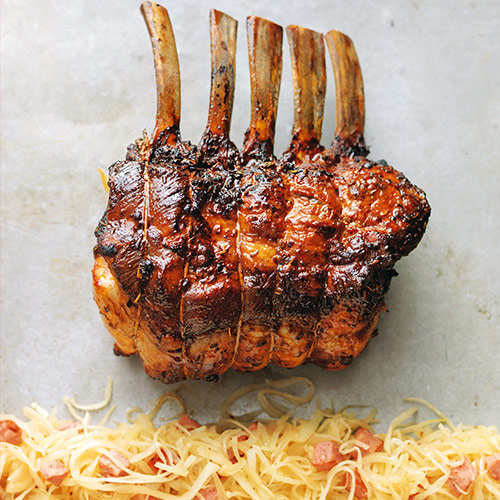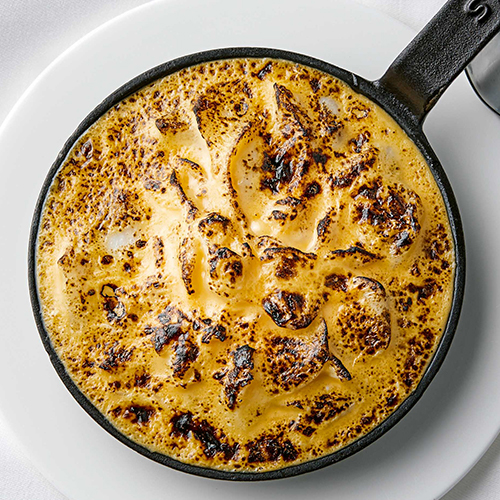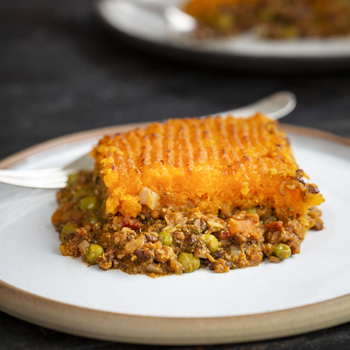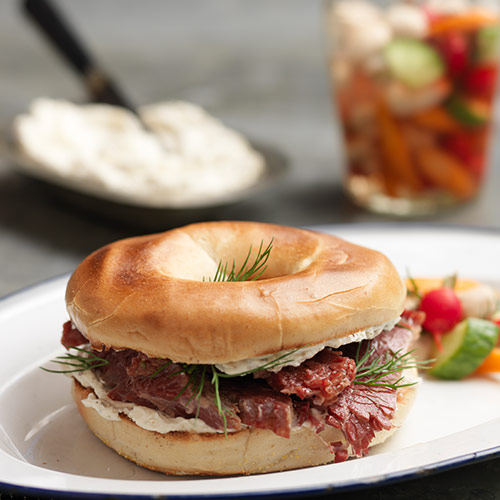Any meat roasted on the bone is brilliant, both for flavour and moistness, but the bone also helps the meat to keep its shape. This great, easy roast is pork’s version of a fore rib of beef. Pork and paprika are such good mates – just ask any Hungarian – and this recipe really shows off their friendship. I love to serve this on a cold evening with some mashed potato made with a little smoked butter. Pure pleasure!

- WIN TWO VIP TICKETS TO PUB IN THE PARK 2024 – T&CS
- WIN TWO PITMASTERS TICKETS TO ST ALBANS PUB IN THE PARK 2024 – T&CS
- WIN £150 VOUCHER FOR THE COACH – TERMS AND CONDITIONS
- WIN 3 COURSE SET MENU LUNCH AT THE HAND & FLOWERS – TERMS AND CONDITIONS
- WIN A HAND & FLOWERS GIFT BUNDLE WORTH OVER £250 – T&CS
- WIN A FAMILY TICKET TO PUB IN THE PARK 2024 – T&CS
- WIN A SIGNED COPY OF TOM KERRIDGE COOKS BRITAIN – T&Cs’
- WIN A SIGNED COPY OF TOM KERRIDGE COOKS BRITAIN – T&Cs’
- WIN A SIGNED COPY OF TOM KERRIDGE’S PUB KITCHEN
- WIN A SIGNED COPY OF TOM KERRIDGE COOKS BRITAIN
- WIN TOUR OF HATTINGLEY VALLEY VINEYARD – T&CS
- WIN A SET OF ALL ELEVEN OF TOM KERRIDGE RECIPE BOOKS – T&CS
- WIN A SIGNED COPY OF TOM KERRIDGE’S PUB KITCHEN BOOK – T&CS
- WIN A £100 VOUCHER FOR KERRIDGE’S BAR AND GRILL
- WIN A ‘TOOTHSOME TUESDAY’ MEAL FOR 2 AT KERRIDGE’S BAR & GRILL, TERMS AND CONDITIONS
- WIN A THREE COURSE MEAL FOR TWO AT KERRIDGE’S FISH & CHIPS TERMS AND CONDITIONS
- WIN A MEAL FOR TWO AT THE BUTCHER’S TAP & GRILL CHELSEA – TERMS AND CONDITIONS
- WIN A MEAL FOR TWO AT THE BUTCHER’S TAP & GRILL CHELSEA – TERMS AND CONDITIONS
- WIN BREAKFAST FOR TWO AT THE COACH IN MARLOW – TERMS AND CONDITIONS
- WIN A MEAL FOR TWO AT THE BUTCHER’S TAP & GRILL – TERMS AND CONDITIONS
- WIN A SET MENU LUNCH FOR TWO AT THE HAND & FLOWERS – TERMS AND CONDITIONS
- WIN A TOM KERRIDGE BEEF WELLINGTON CHRISTMAS BOX – T&Cs
- WIN A MEAL FOR 2 AT KERRIDGE’S FISH & CHIPS TERMS AND CONDITIONS
- HOLLANDAISE SAUCE
- Payment
- Your Saved Recipes
- PIRATES ONLY
- TOM IN THE COMMUNITY
- WHAT’S NEW
- FOOD AND DRINK INSPIRATION
- PRODUCTS
- TOM KERRIDGE IN THE COMMUNITY
- EVENTS
- THANK YOU
- ACCEPTABLE USE POLICY
- MY ACCOUNT
- TOM’S RECIPE BOOKS
- HOME
- PIRATE SHIP PODCASTS
- Privacy and Cookie Policy
- MY FAVOURITE RECIPES
- TOM’S RESTAURANTS
- SIGNUP
- Terms of Use
- COOK-A-LONG VIDEOS
- WIN TWO VIP TICKETS TO PUB IN THE PARK 2024 – T&CS
- WIN TWO PITMASTERS TICKETS TO ST ALBANS PUB IN THE PARK 2024 – T&CS
- WIN £150 VOUCHER FOR THE COACH – TERMS AND CONDITIONS
- WIN 3 COURSE SET MENU LUNCH AT THE HAND & FLOWERS – TERMS AND CONDITIONS
- WIN A HAND & FLOWERS GIFT BUNDLE WORTH OVER £250 – T&CS
- WIN A FAMILY TICKET TO PUB IN THE PARK 2024 – T&CS
- WIN A SIGNED COPY OF TOM KERRIDGE COOKS BRITAIN – T&Cs’
- WIN A SIGNED COPY OF TOM KERRIDGE COOKS BRITAIN – T&Cs’
- WIN A SIGNED COPY OF TOM KERRIDGE’S PUB KITCHEN
- WIN A SIGNED COPY OF TOM KERRIDGE COOKS BRITAIN
- WIN TOUR OF HATTINGLEY VALLEY VINEYARD – T&CS
- WIN A SET OF ALL ELEVEN OF TOM KERRIDGE RECIPE BOOKS – T&CS
- WIN A SIGNED COPY OF TOM KERRIDGE’S PUB KITCHEN BOOK – T&CS
- WIN A £100 VOUCHER FOR KERRIDGE’S BAR AND GRILL
- WIN A ‘TOOTHSOME TUESDAY’ MEAL FOR 2 AT KERRIDGE’S BAR & GRILL, TERMS AND CONDITIONS
- WIN A THREE COURSE MEAL FOR TWO AT KERRIDGE’S FISH & CHIPS TERMS AND CONDITIONS
- WIN A MEAL FOR TWO AT THE BUTCHER’S TAP & GRILL CHELSEA – TERMS AND CONDITIONS
- WIN A MEAL FOR TWO AT THE BUTCHER’S TAP & GRILL CHELSEA – TERMS AND CONDITIONS
- WIN BREAKFAST FOR TWO AT THE COACH IN MARLOW – TERMS AND CONDITIONS
- WIN A MEAL FOR TWO AT THE BUTCHER’S TAP & GRILL – TERMS AND CONDITIONS
- WIN A SET MENU LUNCH FOR TWO AT THE HAND & FLOWERS – TERMS AND CONDITIONS
- WIN A TOM KERRIDGE BEEF WELLINGTON CHRISTMAS BOX – T&Cs
- WIN A MEAL FOR 2 AT KERRIDGE’S FISH & CHIPS TERMS AND CONDITIONS
- HOLLANDAISE SAUCE
- Payment
- Your Saved Recipes
- PIRATES ONLY
- TOM IN THE COMMUNITY
- WHAT’S NEW
- FOOD AND DRINK INSPIRATION
- PRODUCTS
- TOM KERRIDGE IN THE COMMUNITY
- EVENTS
- THANK YOU
- ACCEPTABLE USE POLICY
- MY ACCOUNT
- TOM’S RECIPE BOOKS
- HOME
- PIRATE SHIP PODCASTS
- Privacy and Cookie Policy
- MY FAVOURITE RECIPES
- TOM’S RESTAURANTS
- SIGNUP
- Terms of Use
- COOK-A-LONG VIDEOS











